Shizhou Zhang
Multi-level Collaborative Distillation Meets Global Workspace Model: A Unified Framework for OCIL
Aug 12, 2025Abstract:Online Class-Incremental Learning (OCIL) enables models to learn continuously from non-i.i.d. data streams and samples of the data streams can be seen only once, making it more suitable for real-world scenarios compared to offline learning. However, OCIL faces two key challenges: maintaining model stability under strict memory constraints and ensuring adaptability to new tasks. Under stricter memory constraints, current replay-based methods are less effective. While ensemble methods improve adaptability (plasticity), they often struggle with stability. To overcome these challenges, we propose a novel approach that enhances ensemble learning through a Global Workspace Model (GWM)-a shared, implicit memory that guides the learning of multiple student models. The GWM is formed by fusing the parameters of all students within each training batch, capturing the historical learning trajectory and serving as a dynamic anchor for knowledge consolidation. This fused model is then redistributed periodically to the students to stabilize learning and promote cross-task consistency. In addition, we introduce a multi-level collaborative distillation mechanism. This approach enforces peer-to-peer consistency among students and preserves historical knowledge by aligning each student with the GWM. As a result, student models remain adaptable to new tasks while maintaining previously learned knowledge, striking a better balance between stability and plasticity. Extensive experiments on three standard OCIL benchmarks show that our method delivers significant performance improvement for several OCIL models across various memory budgets.
Adaptive Spatial Augmentation for Semi-supervised Semantic Segmentation
May 29, 2025Abstract:In semi-supervised semantic segmentation (SSSS), data augmentation plays a crucial role in the weak-to-strong consistency regularization framework, as it enhances diversity and improves model generalization. Recent strong augmentation methods have primarily focused on intensity-based perturbations, which have minimal impact on the semantic masks. In contrast, spatial augmentations like translation and rotation have long been acknowledged for their effectiveness in supervised semantic segmentation tasks, but they are often ignored in SSSS. In this work, we demonstrate that spatial augmentation can also contribute to model training in SSSS, despite generating inconsistent masks between the weak and strong augmentations. Furthermore, recognizing the variability among images, we propose an adaptive augmentation strategy that dynamically adjusts the augmentation for each instance based on entropy. Extensive experiments show that our proposed Adaptive Spatial Augmentation (\textbf{ASAug}) can be integrated as a pluggable module, consistently improving the performance of existing methods and achieving state-of-the-art results on benchmark datasets such as PASCAL VOC 2012, Cityscapes, and COCO.
Demystifying Catastrophic Forgetting in Two-Stage Incremental Object Detector
Feb 08, 2025Abstract:Catastrophic forgetting is a critical chanllenge for incremental object detection (IOD). Most existing methods treat the detector monolithically, relying on instance replay or knowledge distillation without analyzing component-specific forgetting. Through dissection of Faster R-CNN, we reveal a key insight: Catastrophic forgetting is predominantly localized to the RoI Head classifier, while regressors retain robustness across incremental stages. This finding challenges conventional assumptions, motivating us to develop a framework termed NSGP-RePRE. Regional Prototype Replay (RePRE) mitigates classifier forgetting via replay of two types of prototypes: coarse prototypes represent class-wise semantic centers of RoI features, while fine-grained prototypes model intra-class variations. Null Space Gradient Projection (NSGP) is further introduced to eliminate prototype-feature misalignment by updating the feature extractor in directions orthogonal to subspace of old inputs via gradient projection, aligning RePRE with incremental learning dynamics. Our simple yet effective design allows NSGP-RePRE to achieve state-of-the-art performance on the Pascal VOC and MS COCO datasets under various settings. Our work not only advances IOD methodology but also provide pivotal insights for catastrophic forgetting mitigation in IOD. Code will be available soon.
ComprehendEdit: A Comprehensive Dataset and Evaluation Framework for Multimodal Knowledge Editing
Dec 17, 2024



Abstract:Large multimodal language models (MLLMs) have revolutionized natural language processing and visual understanding, but often contain outdated or inaccurate information. Current multimodal knowledge editing evaluations are limited in scope and potentially biased, focusing on narrow tasks and failing to assess the impact on in-domain samples. To address these issues, we introduce ComprehendEdit, a comprehensive benchmark comprising eight diverse tasks from multiple datasets. We propose two novel metrics: Knowledge Generalization Index (KGI) and Knowledge Preservation Index (KPI), which evaluate editing effects on in-domain samples without relying on AI-synthetic samples. Based on insights from our framework, we establish Hierarchical In-Context Editing (HICE), a baseline method employing a two-stage approach that balances performance across all metrics. This study provides a more comprehensive evaluation framework for multimodal knowledge editing, reveals unique challenges in this field, and offers a baseline method demonstrating improved performance. Our work opens new perspectives for future research and provides a foundation for developing more robust and effective editing techniques for MLLMs. The ComprehendEdit benchmark and implementation code are available at https://github.com/yaohui120/ComprehendEdit.
Mamba-CL: Optimizing Selective State Space Model in Null Space for Continual Learning
Nov 23, 2024



Abstract:Continual Learning (CL) aims to equip AI models with the ability to learn a sequence of tasks over time, without forgetting previously learned knowledge. Recently, State Space Models (SSMs), particularly the Mamba model, have achieved notable success in computer vision. Building on the strengths of SSMs, this study explores leveraging the Mamba model for CL. Therefore, we introduce Mamba-CL, a framework that continuously fine-tunes the core SSMs of the large-scale Mamba foundation model by updating parameters orthogonal to the feature subspace of previous tasks. This approach theoretically guarantees the consistency objective aiming to preserves consistent output for each SSM module across both previous and current tasks, so as to overcome catastrophic forgetting issue. Specifically, we achieve this goal by deducing the overall consistency constraints on four key time-invariant parameters in the Mamba model, streamlining its recurrent state-space structure and non-linear discretization process in SSM. In practice, we apply the null-space projection to efficiently implement the orthogonality within Mamba model. Extensive experiments on four class-incremental benchmarks demonstrate the effectiveness of Mamba-CL for anti-forgetting, achieving superior performances to state-of-the-art methods. Code is available in the supplementary materials.
Cross-Platform Video Person ReID: A New Benchmark Dataset and Adaptation Approach
Aug 14, 2024



Abstract:In this paper, we construct a large-scale benchmark dataset for Ground-to-Aerial Video-based person Re-Identification, named G2A-VReID, which comprises 185,907 images and 5,576 tracklets, featuring 2,788 distinct identities. To our knowledge, this is the first dataset for video ReID under Ground-to-Aerial scenarios. G2A-VReID dataset has the following characteristics: 1) Drastic view changes; 2) Large number of annotated identities; 3) Rich outdoor scenarios; 4) Huge difference in resolution. Additionally, we propose a new benchmark approach for cross-platform ReID by transforming the cross-platform visual alignment problem into visual-semantic alignment through vision-language model (i.e., CLIP) and applying a parameter-efficient Video Set-Level-Adapter module to adapt image-based foundation model to video ReID tasks, termed VSLA-CLIP. Besides, to further reduce the great discrepancy across the platforms, we also devise the platform-bridge prompts for efficient visual feature alignment. Extensive experiments demonstrate the superiority of the proposed method on all existing video ReID datasets and our proposed G2A-VReID dataset.
Visual Prompt Tuning in Null Space for Continual Learning
Jun 11, 2024
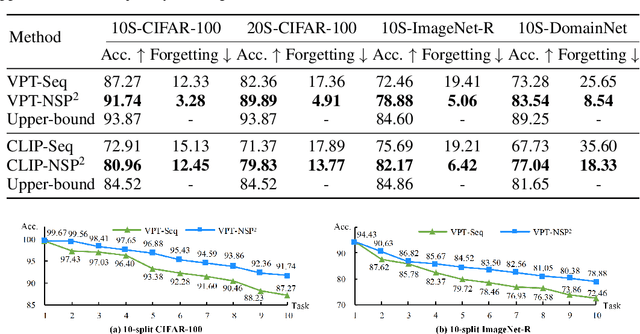
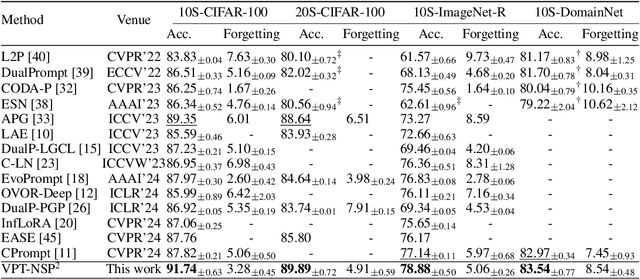
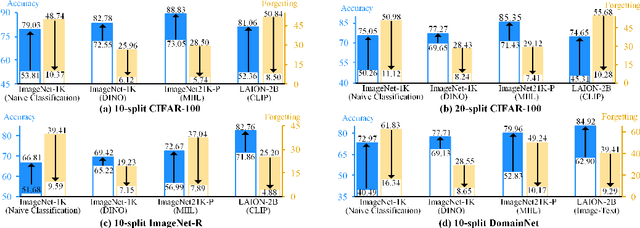
Abstract:Existing prompt-tuning methods have demonstrated impressive performances in continual learning (CL), by selecting and updating relevant prompts in the vision-transformer models. On the contrary, this paper aims to learn each task by tuning the prompts in the direction orthogonal to the subspace spanned by previous tasks' features, so as to ensure no interference on tasks that have been learned to overcome catastrophic forgetting in CL. However, different from the orthogonal projection in the traditional CNN architecture, the prompt gradient orthogonal projection in the ViT architecture shows completely different and greater challenges, i.e., 1) the high-order and non-linear self-attention operation; 2) the drift of prompt distribution brought by the LayerNorm in the transformer block. Theoretically, we have finally deduced two consistency conditions to achieve the prompt gradient orthogonal projection, which provide a theoretical guarantee of eliminating interference on previously learned knowledge via the self-attention mechanism in visual prompt tuning. In practice, an effective null-space-based approximation solution has been proposed to implement the prompt gradient orthogonal projection. Extensive experimental results demonstrate the effectiveness of anti-forgetting on four class-incremental benchmarks with diverse pre-trained baseline models, and our approach achieves superior performances to state-of-the-art methods. Our code is available at https://github.com/zugexiaodui/VPTinNSforCL.
Dual-Modal Prompting for Sketch-Based Image Retrieval
Apr 29, 2024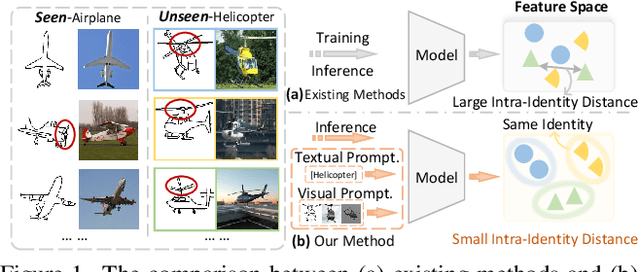

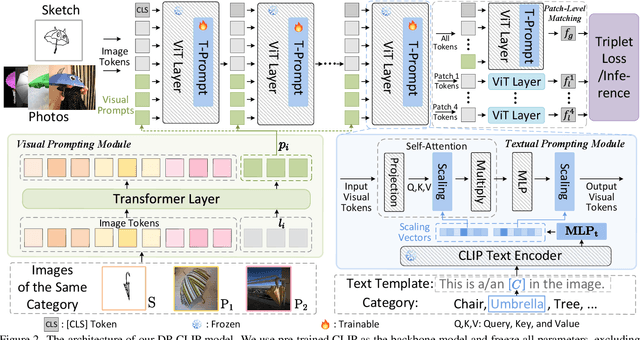
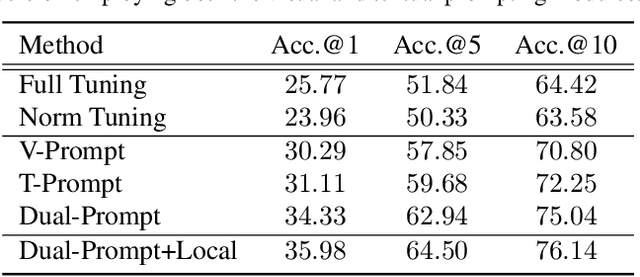
Abstract:Sketch-based image retrieval (SBIR) associates hand-drawn sketches with their corresponding realistic images. In this study, we aim to tackle two major challenges of this task simultaneously: i) zero-shot, dealing with unseen categories, and ii) fine-grained, referring to intra-category instance-level retrieval. Our key innovation lies in the realization that solely addressing this cross-category and fine-grained recognition task from the generalization perspective may be inadequate since the knowledge accumulated from limited seen categories might not be fully valuable or transferable to unseen target categories. Inspired by this, in this work, we propose a dual-modal prompting CLIP (DP-CLIP) network, in which an adaptive prompting strategy is designed. Specifically, to facilitate the adaptation of our DP-CLIP toward unpredictable target categories, we employ a set of images within the target category and the textual category label to respectively construct a set of category-adaptive prompt tokens and channel scales. By integrating the generated guidance, DP-CLIP could gain valuable category-centric insights, efficiently adapting to novel categories and capturing unique discriminative clues for effective retrieval within each target category. With these designs, our DP-CLIP outperforms the state-of-the-art fine-grained zero-shot SBIR method by 7.3% in Acc.@1 on the Sketchy dataset. Meanwhile, in the other two category-level zero-shot SBIR benchmarks, our method also achieves promising performance.
DMAT: A Dynamic Mask-Aware Transformer for Human De-occlusion
Feb 07, 2024Abstract:Human de-occlusion, which aims to infer the appearance of invisible human parts from an occluded image, has great value in many human-related tasks, such as person re-id, and intention inference. To address this task, this paper proposes a dynamic mask-aware transformer (DMAT), which dynamically augments information from human regions and weakens that from occlusion. First, to enhance token representation, we design an expanded convolution head with enlarged kernels, which captures more local valid context and mitigates the influence of surrounding occlusion. To concentrate on the visible human parts, we propose a novel dynamic multi-head human-mask guided attention mechanism through integrating multiple masks, which can prevent the de-occluded regions from assimilating to the background. Besides, a region upsampling strategy is utilized to alleviate the impact of occlusion on interpolated images. During model learning, an amodal loss is developed to further emphasize the recovery effect of human regions, which also refines the model's convergence. Extensive experiments on the AHP dataset demonstrate its superior performance compared to recent state-of-the-art methods.
CrossDiff: Exploring Self-Supervised Representation of Pansharpening via Cross-Predictive Diffusion Model
Jan 13, 2024



Abstract:Fusion of a panchromatic (PAN) image and corresponding multispectral (MS) image is also known as pansharpening, which aims to combine abundant spatial details of PAN and spectral information of MS. Due to the absence of high-resolution MS images, available deep-learning-based methods usually follow the paradigm of training at reduced resolution and testing at both reduced and full resolution. When taking original MS and PAN images as inputs, they always obtain sub-optimal results due to the scale variation. In this paper, we propose to explore the self-supervised representation of pansharpening by designing a cross-predictive diffusion model, named CrossDiff. It has two-stage training. In the first stage, we introduce a cross-predictive pretext task to pre-train the UNet structure based on conditional DDPM, while in the second stage, the encoders of the UNets are frozen to directly extract spatial and spectral features from PAN and MS, and only the fusion head is trained to adapt for pansharpening task. Extensive experiments show the effectiveness and superiority of the proposed model compared with state-of-the-art supervised and unsupervised methods. Besides, the cross-sensor experiments also verify the generalization ability of proposed self-supervised representation learners for other satellite's datasets. We will release our code for reproducibility.
 Add to Chrome
Add to Chrome Add to Firefox
Add to Firefox Add to Edge
Add to Edge